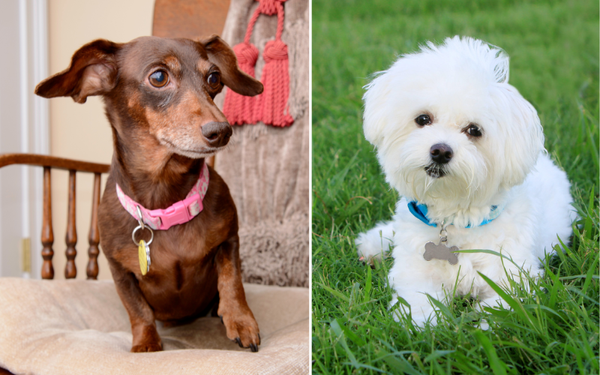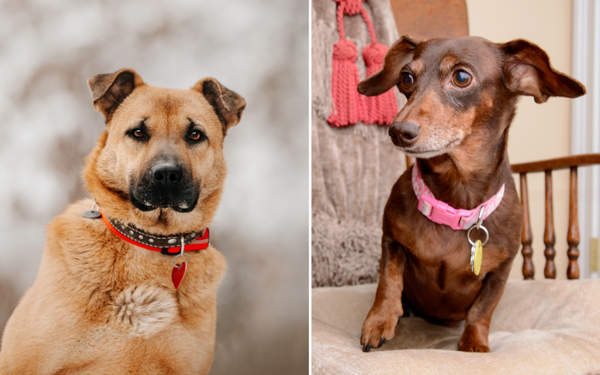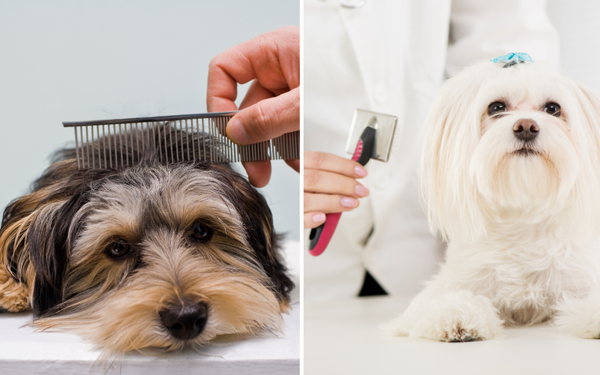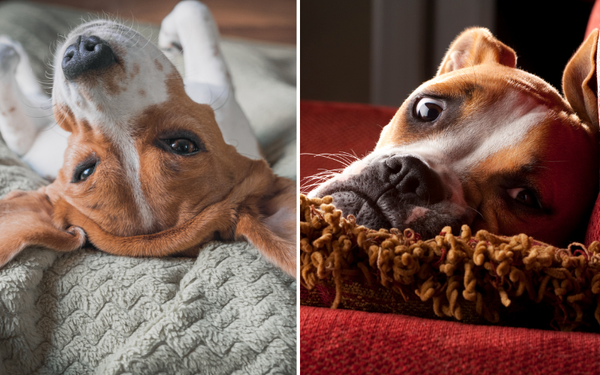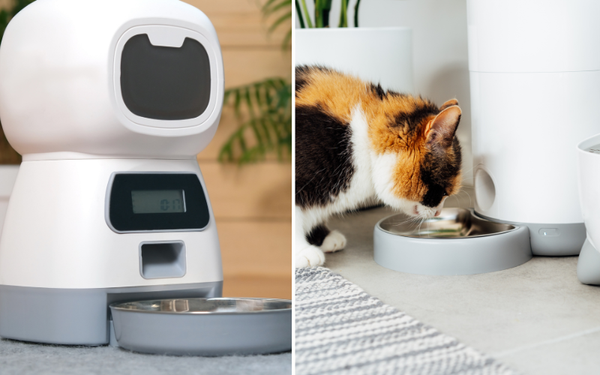Is there a difference between dog scissors and human scissors? Yes. Using the right type of scissors for dog grooming is crucial. Dog grooming scissors are designed specifically to handle the unique texture and density of a dog’s coat, while human scissors are crafted for finer human hair. This article will explore the key differences and why the right choice matters for your pet’s well-being.
Key Takeaways
- Dog grooming scissors are specifically designed for canine hair, featuring various types like straight, curved, thinning shears, and chunkers, each serving different grooming purposes and coat types.
- Compared to human hair scissors, dog grooming scissors have specialized blade designs and sharpness to handle thicker, coarser dog hair, ensuring precision cuts without causing discomfort or injury.
- Ergonomics and build quality are crucial in dog grooming scissors, with handles designed to reduce strain and materials selected for durability, making them more effective and safer for extended grooming sessions.
Introduction
Imagine trying to cut through a rugged denim fabric with a pair of delicate silk scissors; the result would be less than ideal. This analogy rings true when comparing the grooming needs of dogs with human hair styling. With the vast diversity in dog coats, from the wiry hairs of a terrier to the thick fur of a husky, it’s no wonder that dog grooming scissors are a breed apart from their human counterparts.
Eager to know more about grooming? We will delve into the complexities of these indispensable instruments used by master groomers.
Understanding Dog Grooming Scissors
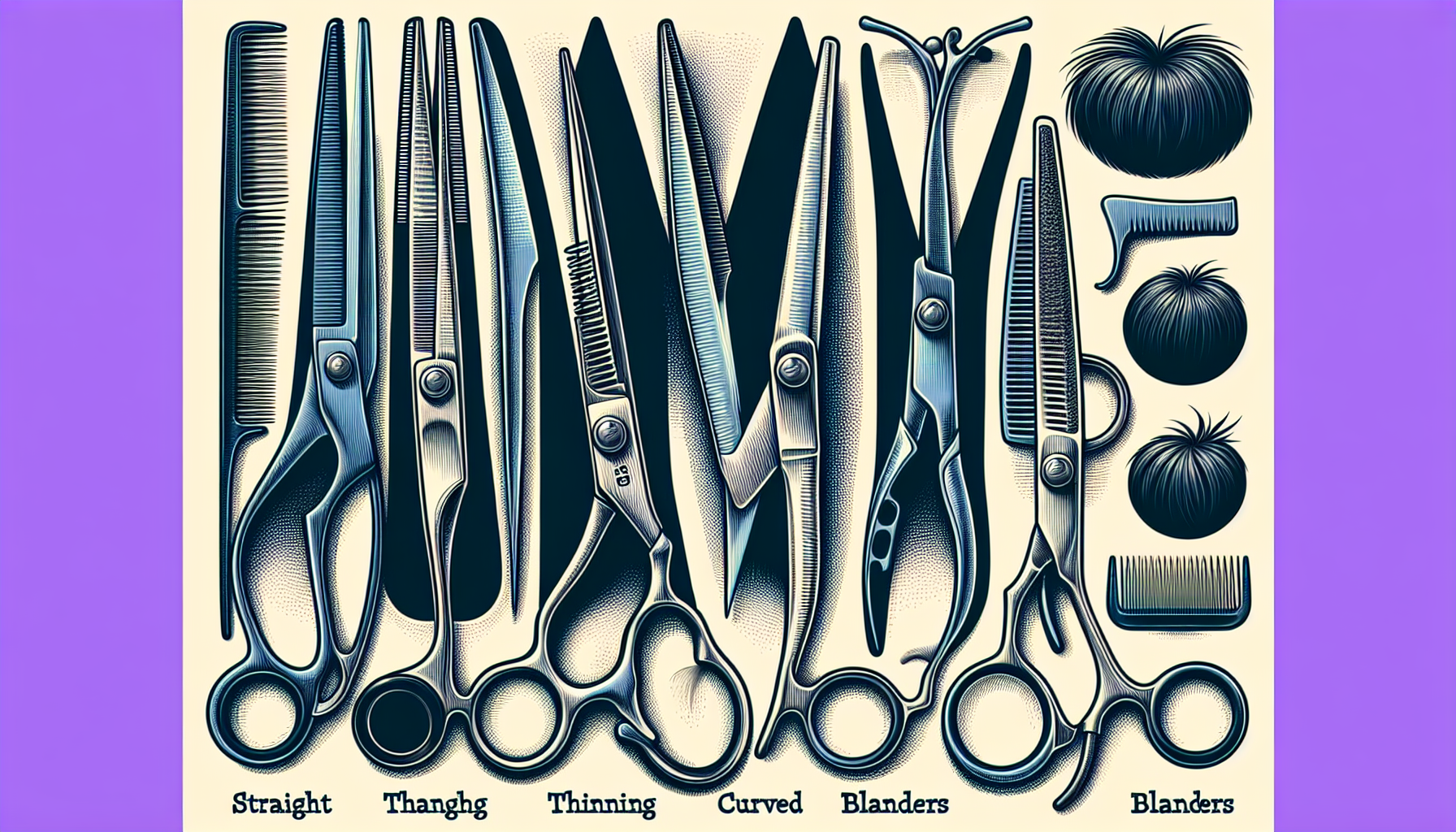
Dog grooming scissors, also known as dog shears, are not your average household shears. They are precision tools designed to tackle the unique challenges of dog hair. These specialized grooming shears come in different shapes and sizes, each serving a distinct purpose in the art of canine coiffure. Skilled groomers know that using the correct pair is paramount for both the safety of the pet and the quality of the cut.
What exactly sets these paper scissors apart?
Types of Dog Grooming Scissors
Dog grooming scissors are the paintbrushes in the hands of an artist. Here are some types of scissors and their uses:
- Straight scissors: the go-to tool for most tasks, providing precision and ease of use on various coat types.
- Curved scissors: also known as curved shears, allow groomers to sculpt rounded edges and perfect those hard-to-reach areas like the head and tail of a poodle or the angulation of a bichon.
- Thinning shears, blenders, and chunkers: for a more textured and layered look. Each with their notched blades designed to remove weight from the coat without leaving harsh lines.
- Chunkers: the heavy-duty cousins in this family, ideal for working through thick curls and creating a natural finish with their wider tooth spacing.
Thinning shears, particularly useful when dealing with dense undercoats or matted areas, often don’t receive the recognition they deserve. Their one notched and one solid blade combo work in harmony to thin out the fur without altering the overall shape. Blenders are the finishing touch, smoothing out transitions for a professional look. These tools, when wielded by an experienced groomer, transform a shaggy dog into a well-manicured pet, reflecting the artistry and precision that dog grooming requires.
Materials and Build Quality
The choice of materials in dog grooming scissors attests to their durability and lifespan. Soft metal scissors, while more affordable, demand frequent sharpening, leading to additional costs over time. Hard metal scissors, on the other hand, are an investment in durability and efficiency. They stay sharp longer, making the grooming process smoother and reducing the strain on the groomer’s hands. The choice between the two often comes down to balancing cost against performance and maintenance expenses.
When pondering the craftsmanship of dog grooming scissors, think of them as fine cutlery. The build quality directly affects the performance, with well-constructed scissors providing cleaner cuts and a longer lifespan. This is why experienced groomers opt for scissors made from high-grade materials, ensuring that their tools can withstand the rigors of daily grooming without faltering.
Key Differences Between Dog Scissors and Human Scissors
Now, we’ll identify and analyze the major differences between scissors designed for dog grooming and those intended for human hair. While both are intended to cut hair, the similarities end there. From the blade’s edge to the handle’s shape, every aspect of dog scissors is tailored to meet the unique challenges of dog grooming.
We’ll delve into these differences, emphasizing the importance of each feature.
Blade Design and Sharpness
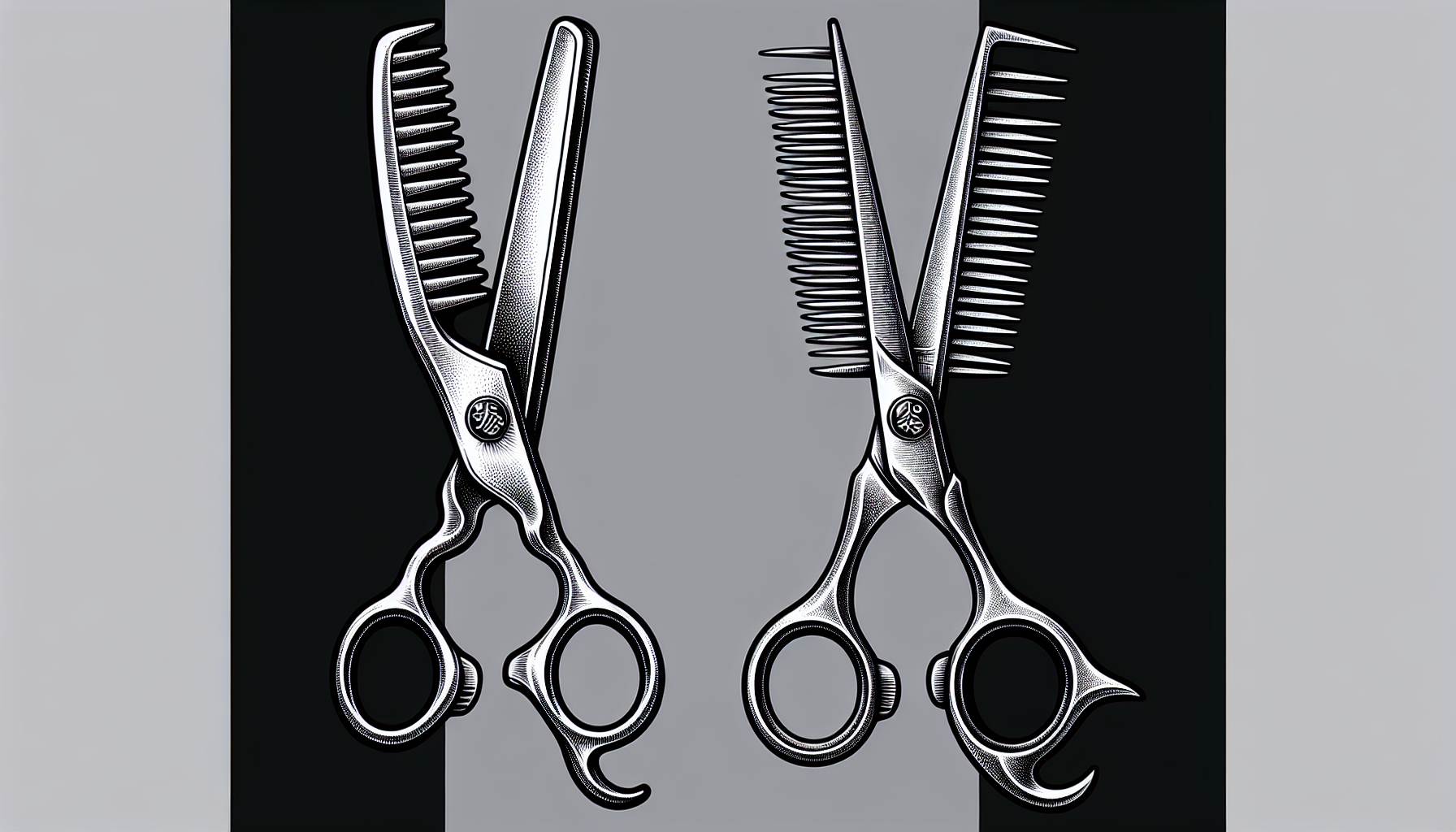
The blades of dog grooming scissors are engineered to remain razor-sharp, cutting through coarse dog hair with precision. Human hair scissors, crafted for finer hair, would quickly become dull if used on a canine’s coat. This stark contrast in blade sharpness is not just about efficiency; it’s about providing a safe grooming experience. The coarser texture of dog hair demands a blade designed to handle its thickness, ensuring a clean cut without pulling or snagging, which could cause discomfort or even injury to the dog.
Moreover, the teeth on dog scissors are spaced and shaped differently to accommodate the various textures found within a dog’s coat. Using human scissors, with their different teeth spacing and lengths, could result in uneven cuts and an unsatisfactory grooming outcome. It is the precise blade design of dog scissors that allows groomers to sculpt a dog’s fur with the finesse of a skilled artist.
Handle and Ergonomics
Ergonomics play an essential role in the design of dog grooming scissors. The handles are crafted to fit comfortably in the groomer’s hand, providing control and reducing fatigue during long grooming sessions. In contrast, human shears might not offer the same level of comfort or control, potentially leading to strain on the groomer’s hands and wrists. This is particularly important when working on areas that require precision, like the dog’s legs or face.
Certain dog scissors, such as those in Level 2 ranges, feature offset handles that align more naturally with the hand’s position. This thoughtful design detail allows for an effortless cutting motion, minimizing the effort required and reducing the risk of repetitive strain injuries. Comfort and control are of paramount importance in grooming tools, as they directly impact the quality of work and the health of the professional wielding them.
Purpose and Usage
Purpose and usage set dog grooming scissors apart from their human counterparts. Dog coats are typically thicker and denser, with a mix of textures that can range from a cotton-soft undercoat to a wiry top coat. Human hair, being finer and lighter, doesn’t require the same level of specialization.
Here are some types of dog grooming scissors and their uses:
- Curved dog grooming scissors: These excel at creating smooth, natural shapes on a dog’s body.
- Blender-style thinning shears: Perfect for finishing touches, tidying uneven areas, and blending shorter areas into longer ones.
- Chunker-style thinners: Particularly effective for large dogs or for giving a natural look to larger areas, such as the legs or bottom.
The specialized designs of dog scissors cater to the diverse needs of different breeds and coat types. Human hair scissors, which lack this level of specialization, are simply not suitable for the varied tasks of dog grooming. Each scissor type in a groomer’s toolkit has a distinct purpose, ensuring that every snip contributes to the dog’s overall well-being and appearance.
Why You Shouldn't Use Human Scissors on Dogs
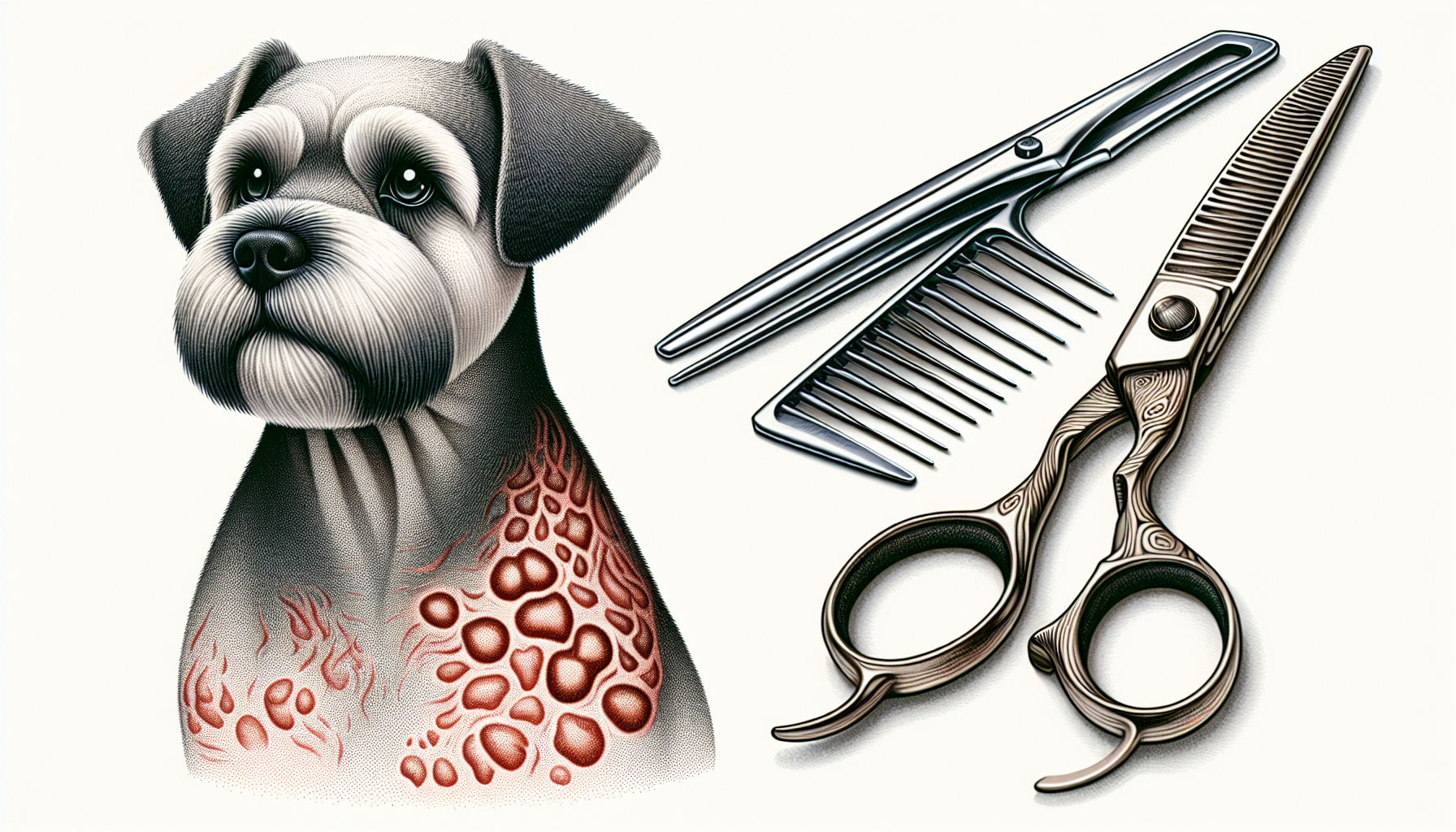
Considering grooming your pet at home? You may be inclined to use a pair of human hair scissors, yet this could inadvertently lead to some undesirable outcomes. Not only can the wrong scissors cause a less-than-desirable finish, but they can also blunt quickly when faced with the tough task of cutting dog hair.
Let’s analyze the reasons why human scissors are not suitable for dog grooming.
Risk of Injury
Using the wrong type of scissors on a dog can significantly increase the risk of injury. Human scissors, which lack the specialized blade design needed for the thicker texture of dog hair, can lead to uneven cuts and, worse, potential skin injuries. This risk is especially high in sensitive areas such as the dog’s face, ears, and paws, which require precision and care. A slip of the blade or a jagged cut could result in a painful nick or even a deep cut, causing distress for both the dog and the owner.
The proper design and sharpness of dog grooming scissors are crucial for safe animal grooming. Human scissors, which are not created with these safety features in mind, make it all too easy for an inexperienced groomer to harm their pet accidentally. It’s not worth the gamble when specialized tools are designed to protect your beloved companion.
Damage to Coat
Beyond the risk to the dog’s skin, using human scissors can cause damage to the coat itself. Blunt cuts can lead to matting and an uneven grooming result that detracts from the natural beauty of a dog’s fur. Human scissors may not be sharp enough to achieve a smooth, natural finish, leading to a poor grooming outcome that can affect both the appearance and the health of the coat.
Inappropriate scissors can also make grooming a frustrating experience for both the groomer and the dog. Instead of gliding through the fur, human scissors might pull or snag, causing discomfort to the dog and making the grooming process more difficult than it needs to be.
It’s clear that the specialized sharpness and design of dog grooming scissors are not just a luxury but a necessity for maintaining a healthy, well-groomed coat.
Choosing the Right Scissors for Your Dog's Coat
What factors should you consider when selecting the right scissors for your dog’s coat? It’s not just about aesthetics; it’s about understanding the specific needs of your pet’s fur and the tasks at hand. Whether you’re a professional groomer or a dedicated pet owner, selecting the right scissors is a decision that impacts not only the grooming experience but also the health and comfort of your dog.
Let’s explore the process of matching the ideal shears to your pet’s unique coat.
Matching Scissors to Coat Types
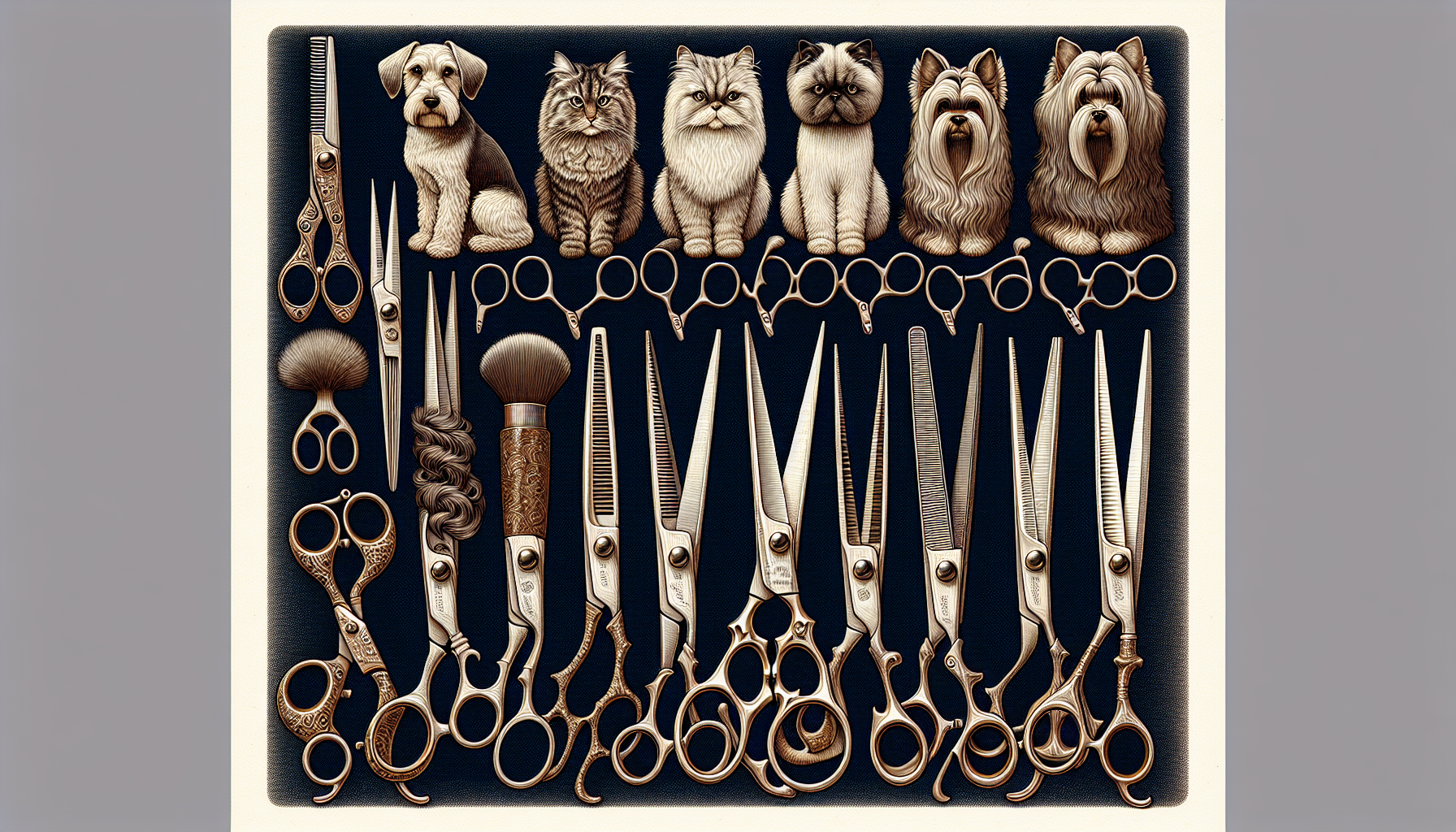
The right pair of scissors is like a key that unlocks the best grooming technique for your dog’s coat. Tailoring your choice to the specific coat type can make all the difference in efficiency and results. For example, scissors with sharper angles and harder steel slice through thick coats with ease, avoiding unnecessary tugging and discomfort. Long blade scissors are the weapon of choice for large breeds or for tackling curly coats, where coverage is key. Conversely, short blade scissors provide the dexterity needed for precision work around delicate areas like the eyes and ears.
Choosing scissors that match your dog’s coat isn’t just about the cut; it’s also about preventing unnecessary stress on the animal. A mismatched pair can lead to pulling and tugging on matted hair or double coats, causing discomfort and possibly even skin irritation. By matching the scissors to the coat type, groomers can ensure a grooming session that’s as smooth and comfortable as possible for the dog.
Length and Size Considerations
The length and size of the scissors you choose play a pivotal role in your grooming success. Smaller scissors offer precision and are ideal for working on small dogs or in intricate areas like the feet. They allow for careful, detailed work that larger scissors simply cannot achieve. On the other end of the spectrum, larger scissors, measuring 9 inches or more, are favored by experienced groomers for efficiently grooming larger breeds. These longer lengths help cover more area with each cut, making the grooming process faster and more consistent.
Choosing the correct scissor length is not just about the size of the dog; it’s also about the groomer’s comfort and control. Longer blades can be unwieldy for someone with smaller hands, while shorter scissors may not provide the necessary reach for larger dogs. It’s about finding the right balance that allows for both precision and ease of use, ensuring that every snip contributes to a beautifully groomed coat.
Maintenance and Care for Dog Grooming Scissors
Upkeeping your dog grooming scissors is as important as choosing the appropriate pair in the first place. Proper care ensures that your scissors remain at their best, providing precise cuts and a long service life. Neglecting this aspect can lead to dull blades, rust, and ultimately, a subpar grooming experience.
Let’s discuss how to maintain your grooming scissors in an excellent condition.
Cleaning and Sanitizing
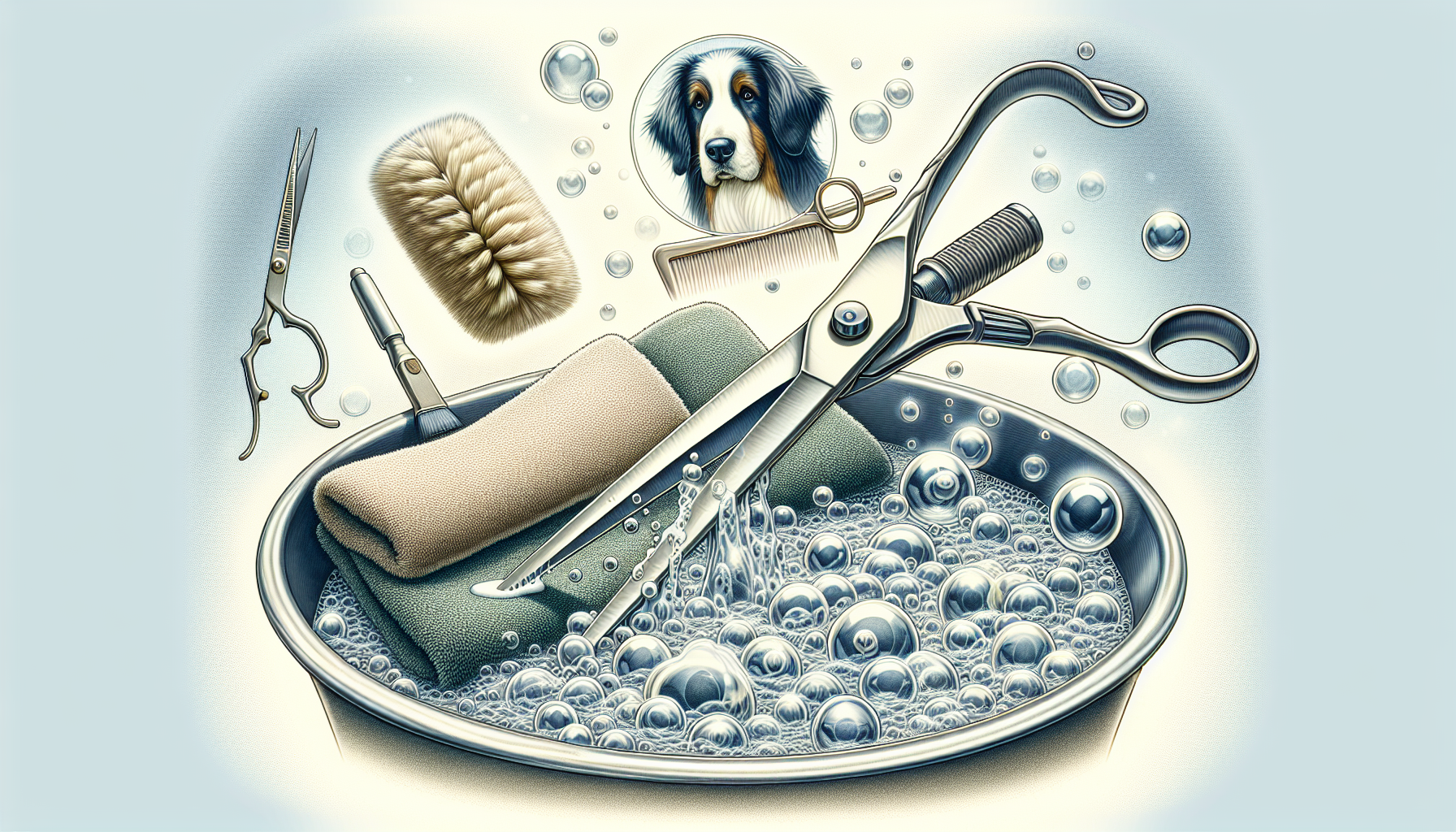
Cleaning and sanitizing dog grooming scissors after each use is a critical step in their upkeep. It prevents the build-up of hair, dirt, and potential pathogens that could lead to rust or infection. Here’s how to clean your dog grooming scissors:
- Wipe the scissors with a damp cloth to remove most debris.
- For a thorough clean, dip the scissors in warm, soapy water to help dislodge any stubborn residues.
- Rinse the scissors with clean water to remove any soap residue.
- Dry the scissors thoroughly with a clean towel to prevent rust, a common enemy of metal tools.
By following these steps, you can ensure that your dog grooming scissors stay clean and in good condition.
Sanitization is equally important, especially in a professional grooming setting where scissors are used on multiple dogs. Rubbing alcohol or ethanol is effective for killing germs, but remember to dry the scissors immediately afterward to avoid moisture-related damage. Maintaining a strict cleaning routine not only extends the life of the scissors but also ensures a hygienic grooming process for every pet.
Sharpening Techniques
Sharp blades are the heart of dog grooming scissors, and keeping them honed is key to smooth, stress-free grooming. Regular sharpening by a professional is recommended to maintain the integrity of the blades and ensure that they cut hair with ease. A simple test with tissue paper can reveal if your scissors are due for a sharpening session. If they can’t cut cleanly through the paper, it’s time to get them sharpened.
Sharpening isn’t just about the edge; it’s also about preserving the blade’s original shape and angle. This precision work is best left to experts who have the tools and knowledge to restore your scissors to their former glory. Regular maintenance, including sharpening, guarantees that your scissors will remain reliable partners in grooming for years to come.
Summary
As we’ve sheared through the information, it’s clear that dog grooming scissors are an indispensable tool in the art of canine grooming. With their specialized design, ergonomic handles, and sharp blades, they cater to the unique textures and needs of various dog coats. Choosing the right scissors, using them correctly, and maintaining them well can make all the difference in achieving a healthy, aesthetically pleasing groom for your furry friend. Remember, investing in the right tools is not just an investment in grooming but in the comfort and happiness of your canine companion.
Frequently Asked Questions
Can I use my hairdressing scissors to trim my dog's fur?
No, it's not recommended to use hairdressing scissors to trim your dog's fur. Dog grooming scissors are designed to handle the texture of dog hair and using the wrong scissors can lead to uneven cuts and potential injury to your dog.
How often should I sharpen my dog grooming scissors?
You should sharpen your dog grooming scissors when they no longer cut smoothly or fail the tissue paper test, which means they can't cleanly cut through a piece of tissue paper. It's recommended to sharpen them based on their performance rather than a specific time frame.
Are longer scissors always better for grooming large dogs?
No, longer scissors can be more efficient for covering large surfaces on bigger dogs, but they also require a steady hand and good technique. It's important to choose a length that you're comfortable handling to ensure precision and safety during grooming.
What's the best way to store my dog grooming scissors?
To keep your dog grooming scissors in good condition, store them in a protective case with a soft lining to prevent damage and moisture exposure. Additionally, always keep them closed and use a toothpick to remove any hair build-up around the screw.
Why are there so many types of dog grooming scissors?
There are many types of dog grooming scissors because they are designed for specific grooming tasks and coat types, such as creating rounded shapes or texturizing the coat. Different scissors serve different purposes in dog grooming.
You Might Also Like...






